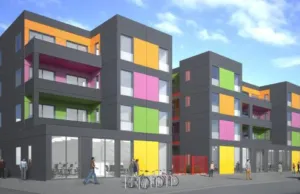Pop-up homeless accommodation: a quick fix for Britain’s housing crisis
Published: by Shelter
The Excalibur Estate in Lewisham has a proud past. It’s the last collection of prefabricated houses which eased the 1940s housing crisis. Bomb damage from the Second World War meant thousands of Britons lost their home overnight. Drastic measures for desperate times!
Less than two miles down the road from Excalibur, Lewisham council are getting involved with prefab again. But this is a drastic response to a very different type of housing crisis. A crumbling municipal leisure center has given way to 24 ‘pop-up’ flats which will be used as temporary accommodation for London’s homeless families. The flats are quickly assembled, with a shelf-life of 4 years.
They will fill up quickly too. A shortage of permanent, affordable, decent housing in the area meant that at least 1,200 families have become homeless in Lewisham in the last 12 months, a fraction of the 112,300 households across England.
New prefab homes in Lewisham (image courtesy of London Borough of Lewisham)
Families who become homeless are once again living in pre-fabs. But not because their homes were flattened by bombs. This time we can blame the ticking time bomb caused by the failure of successive governments to build the homes that we need.
Last week this wooden window box made the news: cheap to build, quickly assembled and equipped with a mattress and storage space, these capsules are designed to offer a roof for those who find themselves sleeping on the streets.
Static pods for people sleeping on the streets (image courtesy of James Furzer)
The window boxes are intended for individuals who are not owed accommodation by their local council. But Lewisham and other councils are now turning to temporary structures to accommodate statutory homeless households, including those with children.
This pile of containers in Brighton could be mistaken for a foreman’s office on a building site, or the quay-side of a major port. It’s not – it’s where up to 36 homeless households call home, many of them owed a legal duty to accommodation. And they will have to stay there until their council can find them somewhere more permanent. Residents of the containers have talked about freezing cold winter nights, cramped conditions and a lack of security.
Shipping containers in Brighton used to house homeless households (image courtesy of James Rippingdale/VICE)
Or how about the ‘Y-Cube’? It’s versatile modular system, which allows units to be stacked on top or alongside each other, has won over street homeless charity YMCA. It’s also been taken up by Newham council, who have championed the design as a type of affordable accommodation for statutory homeless households.
The ‘Y-Cube’ (image courtesy of the Wimbledon Guardian)
Pop-up housing isn’t a modern fad. It’s a drastic measure for a desperate time. And there’s no doubt that as the housing crisis deepens we will need more innovative solutions to house Britain’s families.
The residents of Excalibur estate were reassured by the government that the homes they lost through bomb damage would be replaced with permanent, affordable accommodation. Where is the government’s vision for rehoming the homeless households of 2015? How long will families be living in pre-fabs before they have somewhere to call home?



